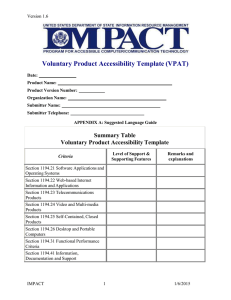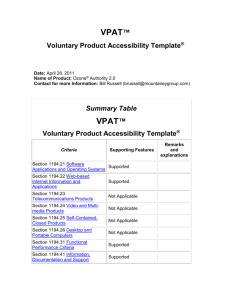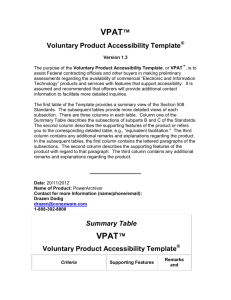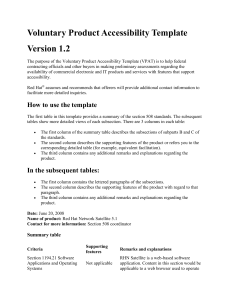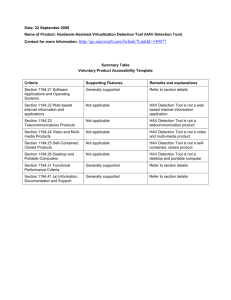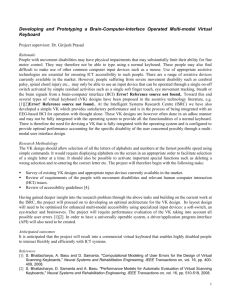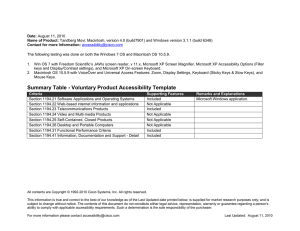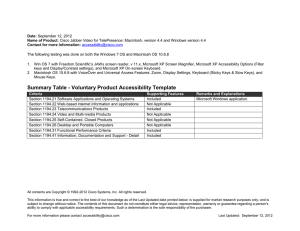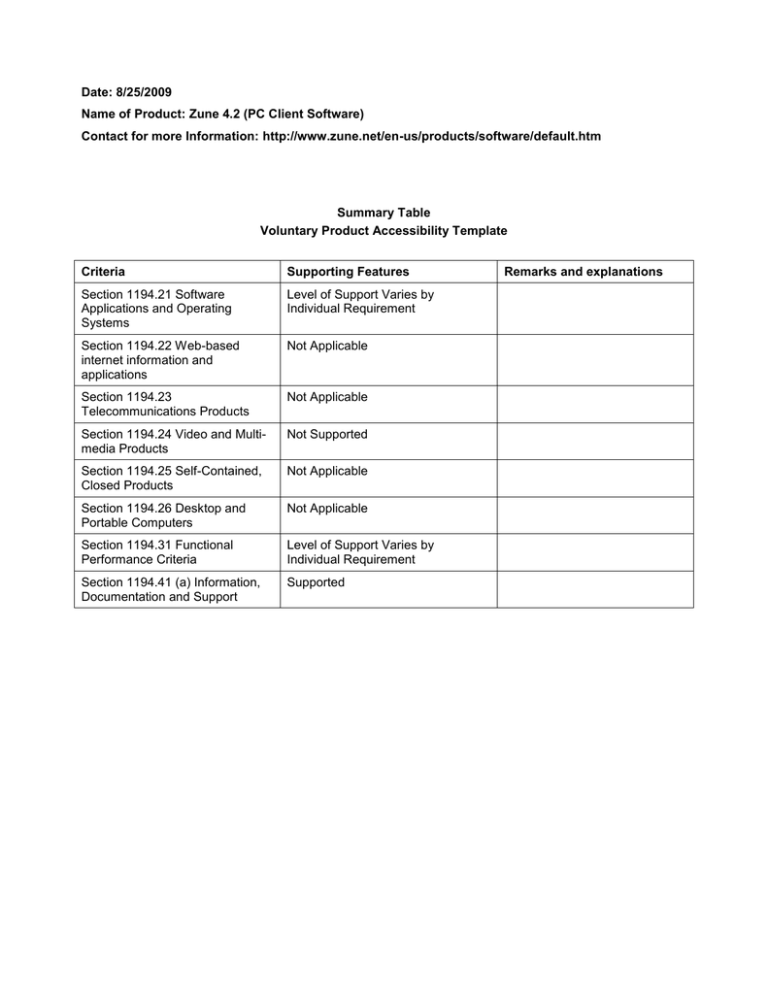
Date: 8/25/2009
Name of Product: Zune 4.2 (PC Client Software)
Contact for more Information: http://www.zune.net/en-us/products/software/default.htm
Summary Table
Voluntary Product Accessibility Template
Criteria
Supporting Features
Section 1194.21 Software
Applications and Operating
Systems
Level of Support Varies by
Individual Requirement
Section 1194.22 Web-based
internet information and
applications
Not Applicable
Section 1194.23
Telecommunications Products
Not Applicable
Section 1194.24 Video and Multimedia Products
Not Supported
Section 1194.25 Self-Contained,
Closed Products
Not Applicable
Section 1194.26 Desktop and
Portable Computers
Not Applicable
Section 1194.31 Functional
Performance Criteria
Level of Support Varies by
Individual Requirement
Section 1194.41 (a) Information,
Documentation and Support
Supported
Remarks and explanations
Section 1194.21 Software Applications and Operating Systems - Detail
Voluntary Product Accessibility Template
Criteria
Supporting Features
Remarks and explanations
(a) When software is designed to
run on a system that has a
keyboard, product functions shall
be executable from a keyboard
where the function itself or the
result of performing a function
can be discerned textually.
Supported with minor
exceptions
The software is keyboard accessible,
including support for tab and arrow
between controls, and keyboard
shortcuts to navigate views and
engage playback controls.
(b) Applications shall not disrupt
or disable activated features of
other products that are identified
as accessibility features, where
those features are developed
and documented according to
industry standards. Applications
also shall not disrupt or disable
activated features of any
operating system that are
identified as accessibility
features where the application
programming interface for those
accessibility features has been
documented by the manufacturer
of the operating system and is
available to the product
developer.
Supported
The software does not disrupt or
disable activated features of other
products identified as accessibility
features.
(c) A well-defined on-screen
indication of the current focus
shall be provided that moves
among interactive interface
elements as the input focus
changes. The focus shall be
programmatically exposed so
that Assistive Technology can
track focus and focus changes.
Supported
The software uses a dotted outline to
show which element currently has
keyboard focus.
Some low priority features are
inaccessible:
21366: Context menu on CD art in CD
rip view is not accessible via keyboard
43609: Setting for Slideshow speed
cannot be altered by arrow keys
88287: Cannot easily change rating
control on playback bar using keyboard
94865: Can't remove a computer from
Settings > Account using keyboard.
105179: Cannot keyboard access the
error icon on a track in Now Playing
133237: Cannot remove an Artist from
the Artist picker using keyboard
The focus is programmatically exposed
so that Screen Readers and other
assistive technology can determine
where focus resides.
(d) Sufficient information about a
user interface element including
the identity, operation and state
of the element shall be available
to Assistive Technology. When
an image represents a program
element, the information
conveyed by the image must
also be available in text.
Supported
(e) When bitmap images are
used to identify controls, status
indicators, or other programmatic
elements, the meaning assigned
to those images shall be
consistent throughout an
application's performance.
Supported
(f) Textual information shall be
provided through operating
system functions for displaying
text. The minimum information
that shall be made available is
text content, text input caret
location, and text attributes.
Supported with minor
exceptions
(g) Applications shall not
override user selected contrast
and color selections and other
individual display attributes.
Not Supported
The software ensures that on-screen
elements are named and given
appropriate roles through MSAA.
There are very few on-screen elements
represented solely by images, but
where there are they have tooltips and
the same text that’s on the tooltip is
accessible to MSAA for Assistive
Technologies.
Images are used consistently through
the app such that each time an image
is used (eg. The ‘Play’ triangle) it has
consistent naming and functionality.
Other images that are used
consistently include:
- ‘Back’ arrow
- Playback controls: Next,
Previous, Shuffle, Repeat,
Heart Rating
- Access to features: Mixview
and SmartDJ
Text is available for text boxes in the
product.
Text attributes and caret location are
not exposed but text entry in the
software is always simple (single line)
and text attributes (font, color, bold) are
unnecessary unchangeable and
unnecessary for use of the product.
The software does not support highcontrast schemes. If the user has set
high contrast in Windows this will not
be reflected in the software
The software supports DPIs of 96 and
120. A user can also run the software
at higher DPIs but there will be some
loss in fidelity including stretched visual
assets and some functionality may be
inaccessible.
(h) When animation is displayed,
the information shall be
displayable in at least one nonanimated presentation mode at
the option of the user.
Supported
The software allows a user to disable
animations from Settings.
(i) Color coding shall not be used
as the only means of conveying
information, indicating an action,
prompting a response, or
distinguishing a visual element.
Supported with minor
exceptions
In most cases the software uses at
least one other method for conveying
info other than color. For example, the
currently playing track is pink in the
collection, but all has an icon beside it
to indicate it is playing.
There is one place in which the current
‘view’ is indicated by a different colored
view title. In Compact Mode the current
view is pink while the other view is
grey. In this case the brightness of the
text will indicate which view the user is
on.
(j) When a product permits a
user to adjust color and contrast
settings, a variety of color
selections capable of producing
a range of contrast levels shall
be provided.
Not Supported
The software has no settings for color
or contrast.
(k) Software shall not use
flashing or blinking text, objects,
or other elements having a flash
or blink frequency greater than 2
Hz and lower than 55 Hz.
Supported
The software has no flashing or
blinking
(l) When electronic forms are
used, the form shall allow people
using Assistive Technology to
access the information, field
elements, and functionality
required for completion and
submission of the form, including
all directions and cues.
Supported with minor
exceptions
The use of forms is very limited in the
software but people using Assistive
Technology can access information,
field elements and functionality in forms
where they exist.
An exception is account creation in
which a visual-only Human Interactive
(CAPTCHA)element may prevent some
accessible users from completing the
process.
Section 1194.22 Web-based Internet information and applications - Detail
Voluntary Product Accessibility Template
Criteria
Supporting Features
(a) A text equivalent for every
non-text element shall be
provided (e.g., via "alt",
"longdesc", or in element
content).
Not Applicable
(b) Equivalent alternatives for
any multimedia presentation
shall be synchronized with the
presentation.
Not Applicable
(c) Web pages shall be designed
so that all information conveyed
with color is also available
without color, for example from
context or markup.
Not Applicable
(d) Documents shall be
organized so they are readable
without requiring an associated
style sheet.
Not Applicable
(e) Redundant text links shall be
provided for each active region
of a server-side image map.
Not Applicable
(f) Client-side image maps shall
be provided instead of serverside image maps except where
the regions cannot be defined
with an available geometric
shape.
Not Applicable
(g) Row and column headers
shall be identified for data tables.
Not Applicable
(h) Markup shall be used to
associate data cells and header
cells for data tables that have
two or more logical levels of row
or column headers.
Not Applicable
(i) Frames shall be titled with text
that facilitates frame
identification and navigation
Not Applicable
(j) Pages shall be designed to
avoid causing the screen to
flicker with a frequency greater
than 2 Hz and lower than 55 Hz.
Not Applicable
Remarks and explanations
(k) A text-only page, with
equivalent information or
functionality, shall be provided to
make a web site comply with the
provisions of this part, when
compliance cannot be
accomplished in any other way.
The content of the text-only page
shall be updated whenever the
primary page changes.
Not Applicable
(l) When pages utilize scripting
languages to display content, or
to create interface elements, the
information provided by the
script shall be identified with
functional text that can be read
by Assistive Technology.
Not Applicable
(m) When a web page requires
that an applet, plug-in or other
application be present on the
client system to interpret page
content, the page must provide a
link to a plug-in or applet that
complies with §1194.21(a)
through (l).
Not Applicable
(n) When electronic forms are
designed to be completed online, the form shall allow people
using Assistive Technology to
access the information, field
elements, and functionality
required for completion and
submission of the form, including
all directions and cues.
Not Applicable
(o) A method shall be provided
that permits users to skip
repetitive navigation links.
Not Applicable
(p) When a timed response is
required, the user shall be
alerted and given sufficient time
to indicate more time is required.
Not Applicable
Section 1194.23 Telecommunications Products - Detail
Voluntary Product Accessibility Template
Criteria
Supporting Features
(a) Telecommunications products
or systems which provide a
function allowing voice
communication and which do not
themselves provide a TTY
functionality shall provide a
standard non-acoustic connection
point for TTYs. Microphones shall
be capable of being turned on
and off to allow the user to
intermix speech with TTY use.
Not Applicable
(b) Telecommunications products
which include voice
communication functionality shall
support all commonly used crossmanufacturer non-proprietary
standard TTY signal protocols.
Not Applicable
(c) Voice mail, auto-attendant,
and interactive voice response
telecommunications systems shall
be usable by TTY users with their
TTYs.
Not Applicable
(d) Voice mail, messaging, autoattendant, and interactive voice
response telecommunications
systems that require a response
from a user within a time interval,
shall give an alert when the time
interval is about to run out, and
shall provide sufficient time for the
user to indicate more time is
required.
Not Applicable
(e) Where provided, caller
identification and similar
telecommunications functions
shall also be available for users of
TTYs, and for users who cannot
see displays.
Not Applicable
(f) For transmitted voice signals,
telecommunications products
shall provide a gain adjustable up
to a minimum of 20 dB. For
incremental volume control, at
least one intermediate step of 12
dB of gain shall be provided.
Not Applicable
Remarks and explanations
(g) If the telecommunications
product allows a user to adjust
the receive volume, a function
shall be provided to automatically
reset the volume to the default
level after every use.
Not Applicable
(h) Where a telecommunications
product delivers output by an
audio transducer which is
normally held up to the ear, a
means for effective magnetic
wireless coupling to hearing
technologies shall be provided.
Not Applicable
(i) Interference to hearing
technologies (including hearing
aids, cochlear implants, and
assistive listening devices) shall
be reduced to the lowest possible
level that allows a user of hearing
technologies to utilize the
telecommunications product.
Not Applicable
(j) Products that transmit or
conduct information or
communication, shall pass
through cross-manufacturer, nonproprietary, industry-standard
codes, translation protocols,
formats or other information
necessary to provide the
information or communication in a
usable format. Technologies
which use encoding, signal
compression, format
transformation, or similar
techniques shall not remove
information needed for access or
shall restore it upon delivery.
Not Applicable
(k)(1) Products which have
mechanically operated controls or
keys shall comply with the
following: Controls and Keys shall
be tactilely discernible without
activating the controls or keys.
Not Applicable
(k)(2) Products which have
mechanically operated controls or
keys shall comply with the
following: Controls and Keys shall
be operable with one hand and
shall not require tight grasping,
pinching, twisting of the wrist. The
force required to activate controls
and keys shall be 5 lbs. (22.2N)
maximum.
Not Applicable
(k)(3) Products which have
mechanically operated controls or
keys shall comply with the
following: If key repeat is
supported, the delay before
repeat shall be adjustable to at
least 2 seconds. Key repeat rate
shall be adjustable to 2 seconds
per character.
Not Applicable
(k)(4) Products which have
mechanically operated controls or
keys shall comply with the
following: The status of all locking
or toggle controls or keys shall be
visually discernible, and
discernible either through touch or
sound.
Not Applicable
Section 1194.24 Video and Multi-media Products - Detail
Voluntary Product Accessibility Template
Criteria
Supporting Features
a) All analog television displays
13 inches and larger, and
computer equipment that
includes analog television
receiver or display circuitry, shall
be equipped with caption
decoder circuitry which
appropriately receives, decodes,
and displays closed captions
from broadcast, cable,
videotape, and DVD signals. As
soon as practicable, but not later
than July 1, 2002, widescreen
digital television (DTV) displays
measuring at least 7.8 inches
vertically, DTV sets with
conventional displays measuring
at least 13 inches vertically, and
stand-alone DTV tuners, whether
or not they are marketed with
display screens, and computer
equipment that includes DTV
receiver or display circuitry, shall
be equipped with caption
decoder circuitry which
appropriately receives, decodes,
and displays closed captions
from broadcast, cable,
videotape, and DVD signals.
Not Applicable
(b) Television tuners, including
tuner cards for use in computers,
shall be equipped with
secondary audio program
playback circuitry.
Not Applicable
(c) All training and informational
video and multimedia
productions which support the
agency's mission, regardless of
format, that contain speech or
other audio information
necessary for the
comprehension of the content,
shall be open or closed
captioned.
Not Supported
Remarks and explanations
The software does not support
closed captioning for video
content.
(d) All training and informational
video and multimedia
productions which support the
agency's mission, regardless of
format, that contain visual
information necessary for the
comprehension of the content,
shall be audio described.
Not Supported
The software does not support a
secondary audio track for audio
descriptions
(e) Display or presentation of
alternate text presentation or
audio descriptions shall be userselectable unless permanent.
Not Supported
The software does not support
closed captioning for video
content.
Section 1194.25 Self-Contained, Closed Products - Detail
Voluntary Product Accessibility Template
Criteria
Supporting Features
(a) Self contained products shall
be usable by people with
disabilities without requiring an
end-user to attach Assistive
Technology to the product.
Personal headsets for private
listening are not Assistive
Technology.
Not Applicable
(b) When a timed response is
required, the user shall be
alerted and given sufficient time
to indicate more time is required.
Not Applicable
(c) Where a product utilizes
touch screens or contactsensitive controls, an input
method shall be provided that
complies with §1194.23 (k) (1)
through (4).
Not Applicable
(d) When biometric forms of user
identification or control are used,
an alternative form of
identification or activation, which
does not require the user to
possess particular biological
characteristics, shall also be
provided.
Not Applicable
(e) When products provide
auditory output, the audio signal
shall be provided at a standard
signal level through an industry
standard connector that will
allow for private listening. The
product must provide the ability
to interrupt, pause, and restart
the audio at anytime.
Not Applicable
(f) When products deliver voice
output in a public area,
incremental volume control shall
be provided with output
amplification up to a level of at
least 65 dB. Where the ambient
noise level of the environment is
above 45 dB, a volume gain of at
least 20 dB above the ambient
level shall be user selectable. A
function shall be provided to
automatically reset the volume to
the default level after every use.
Not Applicable
Remarks and explanations
(g) Color coding shall not be
used as the only means of
conveying information, indicating
an action, prompting a response,
or distinguishing a visual
element.
Not Applicable
(h) When a product permits a
user to adjust color and contrast
settings, a range of color
selections capable of producing
a variety of contrast levels shall
be provided.
Not Applicable
(i) Products shall be designed to
avoid causing the screen to
flicker with a frequency greater
than 2 Hz and lower than 55 Hz.
Not Applicable
(j) (1) Products which are
freestanding, non-portable, and
intended to be used in one
location and which have
operable controls shall comply
with the following: The position
of any operable control shall be
determined with respect to a
vertical plane, which is 48 inches
in length, centered on the
operable control, and at the
maximum protrusion of the
product within the 48 inch length
on products which are
freestanding, non-portable, and
intended to be used in one
location and which have
operable controls.
Not Applicable
(j)(2) Products which are
freestanding, non-portable, and
intended to be used in one
location and which have
operable controls shall comply
with the following: Where any
operable control is 10 inches or
less behind the reference plane,
the height shall be 54 inches
maximum and 15 inches
minimum above the floor.
Not Applicable
(j)(3) Products which are
freestanding, non-portable, and
intended to be used in one
location and which have
operable controls shall comply
with the following: Where any
operable control is more than 10
inches and not more than 24
inches behind the reference
plane, the height shall be 46
inches maximum and 15 inches
minimum above the floor.
Not Applicable
(j)(4) Products which are
freestanding, non-portable, and
intended to be used in one
location and which have
operable controls shall comply
with the following: Operable
controls shall not be more than
24 inches behind the reference
plane.
Not Applicable
Section 1194.26 Desktop and Portable Computers - Detail
Voluntary Product Accessibility Template
Criteria
Supporting Features
(a) All mechanically operated
controls and keys shall comply
with §1194.23 (k) (1) through
(4).
Not Applicable
(b) If a product utilizes touch
screens or touch-operated
controls, an input method shall
be provided that complies with
§1194.23 (k) (1) through (4).
Not Applicable
(c) When biometric forms of user
identification or control are used,
an alternative form of
identification or activation, which
does not require the user to
possess particular biological
characteristics, shall also be
provided.
Not Applicable
(d) Where provided, at least one
of each type of expansion slots,
ports and connectors shall
comply with publicly available
industry standards
Not Applicable
Remarks and explanations
Section 1194.31 Functional Performance Criteria - Detail
Voluntary Product Accessibility Template
Criteria
Supporting Features
Remarks and explanations
Supported with minor exceptions
The software ensures that onscreen elements are named and
given appropriate roles through
MSAA.
(a) At least one mode of
operation and information
retrieval that does not require
user vision shall be provided, or
support for Assistive Technology
used by people who are blind or
visually impaired shall be
provided.
There are very few on-screen
elements represented solely by
images, but where there are they
have tooltips and the same text
that’s on the tooltip is accessible
to MSAA for Assistive
Technologies.
Not Supported
(b) At least one mode of
operation and information
retrieval that does not require
visual acuity greater than 20/70
shall be provided in audio and
enlarged print output working
together or independently, or
support for Assistive Technology
used by people who are visually
impaired shall be provided.
The software does not support
high-contrast schemes. If the
user has set high contrast in
Windows this will not be reflected
in the software
The software supports DPIs of 96
and 120. A user can also run the
software at higher DPIs but there
will be some loss in fidelity
including stretched visual assets
and some functionality may be
inaccessible.
(c) At least one mode of
operation and information
retrieval that does not require
user hearing shall be provided,
or support for Assistive
Technology used by people who
are deaf or hard of hearing shall
be provided
Not Supported
The software does not support
closed captioning for video
content.
(d) Where audio information is
important for the use of a
product, at least one mode of
operation and information
retrieval shall be provided in an
enhanced auditory fashion, or
support for assistive hearing
devices shall be provided.
Not Supported
The software does not support
closed captioning for video
content.
(e) At least one mode of
operation and information
retrieval that does not require
user speech shall be provided,
or support for Assistive
Technology used by people with
disabilities shall be provided.
(f) At least one mode of
operation and information
retrieval that does not require
fine motor control or
simultaneous actions and that is
operable with limited reach and
strength shall be provided.
Supported
The software never requires
speech as an input mechanism.
Supported with minor exceptions
The software is keyboard
accessible, including support for
tab and arrow between controls,
and keyboard shortcuts to
navigate views and engage
playback controls.
Some low priority features are
inaccessible:
21366: Context menu on CD art
in CD rip view is not accessible
via keyboard
43609: Setting for Slideshow
speed cannot be altered by arrow
keys
88287: Cannot easily change
rating control on playback bar
using keyboard
94865: Can't remove a computer
from Settings > Account using
keyboard.
105179: Cannot keyboard access
the error icon on a track in Now
Playing
133237: Cannot remove an Artist
from the Artist picker using
keyboard
Section 1194.41 Information, Documentation, and Support - Detail
Voluntary Product Accessibility Template
Criteria
Supporting Features
Remarks and explanations
Section 1194.41 (a) Product
Support Documentation
provided to end-users shall be
made available in alternate
formats upon request, at no
additional charge.
Supported
The software has product support
documentation (Help) available on
the web in an accessible format.
http://www.zune.net/en-us/support/
Section 1194.41 (b)
Accessibility and Compatibility
Features. End-users shall
have access to a description of
the accessibility and
compatibility features of
products in alternate formats or
alternate methods upon
request, at no additional
charge.
Supported
The software has product support
documentation (Help) available on
the web in an accessible format
http://www.zune.net/en-us/support
1194.41 (c) Support Services
for products shall
accommodate the
communication needs of endusers with disabilities.
Supported
The software has a TTY number for
the hearing impaired.The number is
listed on our ‘contact support’ page.
http://www.zune.net/enus/support/contactsupport.htm
This document is for informational purposes only. MICROSOFT MAKES NO WARRANTIES, EXPRESS OR
IMPLIED, IN THIS DOCUMENT.
© 2002 Microsoft Corporation. All rights reserved. Microsoft, Zune and Zune logo are either registered
trademarks or trademarks of Microsoft Corporation in the United States and/or other countries. The names of
actual companies and products mentioned herein may be the trademarks of their respective owners. The
information contained in this document represents the current view of Microsoft Corporation on the issues
discussed as of the date of publication. Because Microsoft must respond to changing market conditions, it
should not be interpreted to be a commitment on the part of Microsoft, and Microsoft cannot guarantee the
accuracy of any information presented after the date of publication.
Revised 12/14/09 Microsoft regularly updates its websites and provides new information about the
accessibility of products as that information becomes available.

